Another example of the late artist’s considerable impact…
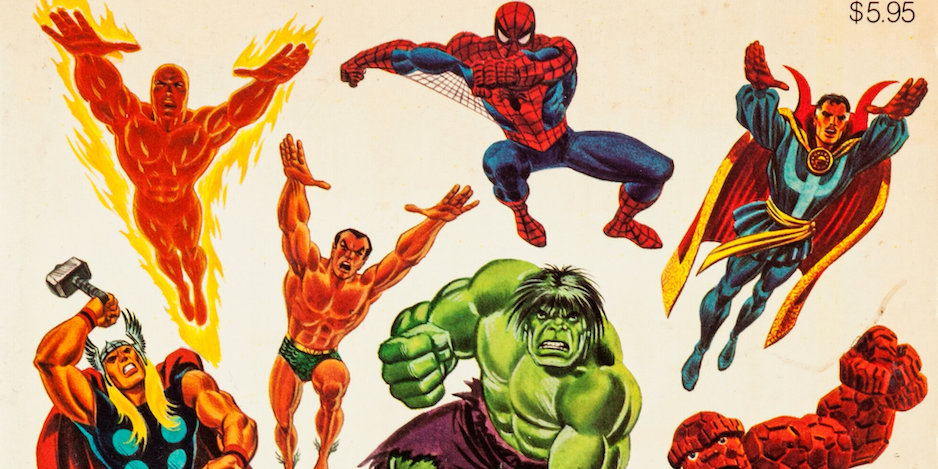
By CHRIS FRANKLIN
John Romita Sr., who died in June at the age of 93, didn’t co-author How to Draw Comics The Marvel Way, but he should have. Now, that is not at all a dig at the legendary “Big” John Buscema, who did co-author that immortal tome with Stan Lee, which launched thousands of would-be comic artists. Buscema is an icon, and his work screams “Marvel.” But John Romita’s slick, easily digestible, but not-at-all-simplistic style defined the look of Marvel’s greatest character — one of pop culture’s most enduring literary and pop culture heroes. Romita is THE Spider-Man artist, and again, that’s no dig at Spidey’s co-creator Steve Ditko. But the classic image of Spidey was defined by Romita, who had a hand in illustrating and crafting the web-slinger’s stories for over a decade. Why does Tom Holland’s Spider-Man mask look so comic accurate and spot-on? Because it’s based on Romita’s interpretation of the character.
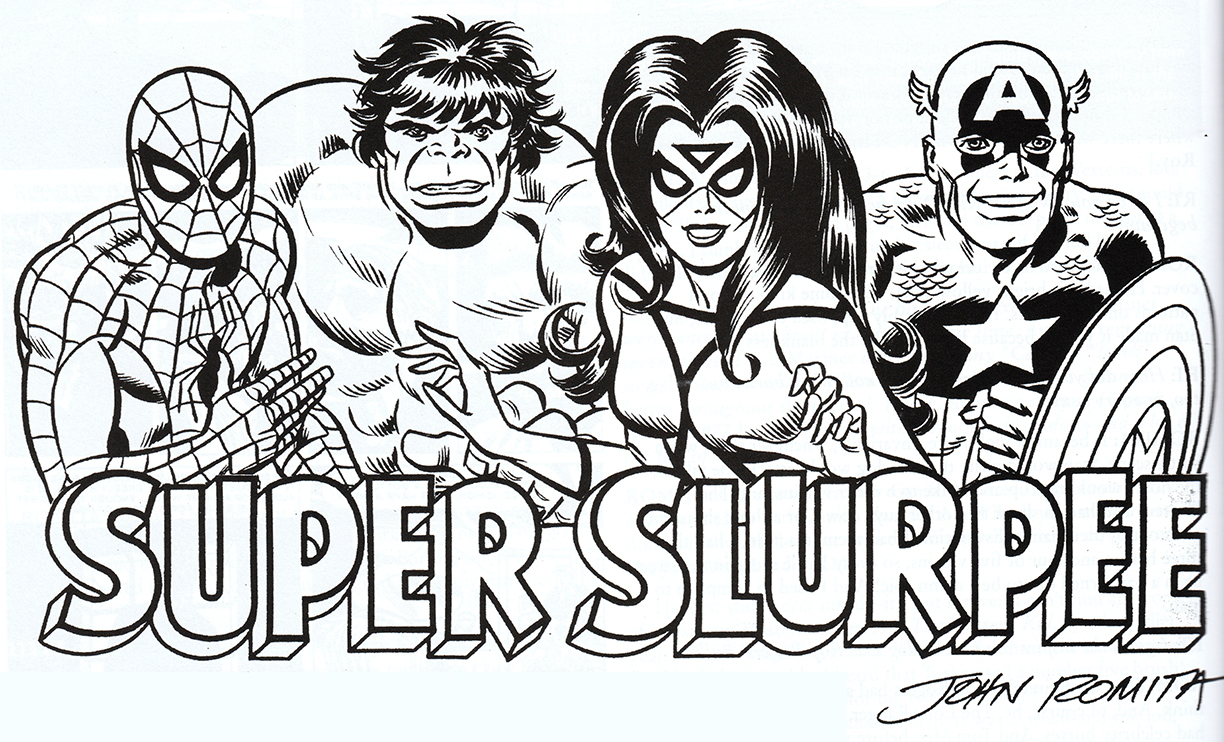
If Romita had only ever illustrated Spider-Man, his legendary status would be assured. But he drew far more than the wall-crawler. Romita had solid runs on Daredevil, and Captain America (the first Marvel superhero he ever drew for Atlas Comics back in the late Golden Age) and stepped in to take over Fantastic Four when Marvel Universe co-architect Jack Kirby left for DC. Moreover, Romita did a LOT of covers for Marvel. And as the company’s art director (both officially and unofficially) for years, his ink brush touched more covers than he’s given credit for. Just look at any sampling of Marvel covers from the ’70s, and you’re sure to see at least a touched-up Romita face, keeping everything in Marvel’s house style. Because that’s what Romita established, the look of Marvel Comics.
By the time Kirby left, he had evolved into something somewhat beyond standard superhero art. His work was exciting, but not quite as accessible as Romita’s smooth stylings. So, when Marvel ascended to a level of merchandising that rivaled DC Comics, it was primarily Romita’s Marvel Universe that was front and center on every product imaginable. From action-figure packaging, to calendars, to hardback book collections, to record albums, and all things in between.
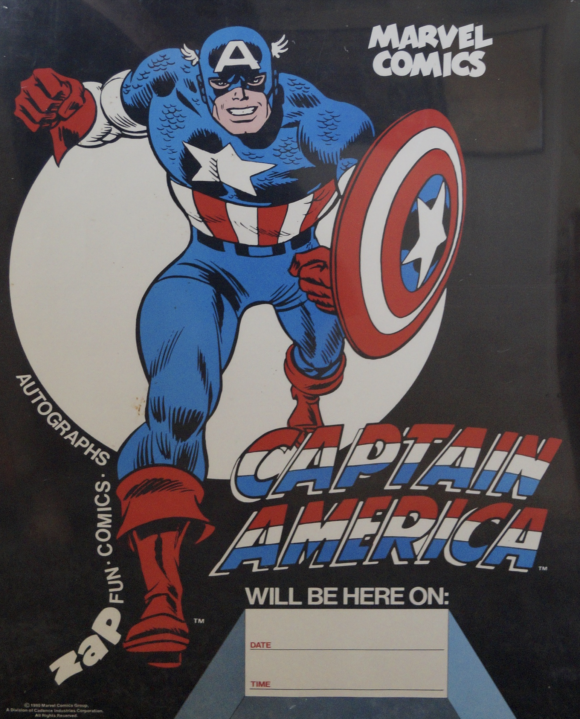
What follows are just 13 examples of Jazzy John’s art, selling not just the product in question, but the very concept of the cohesive Marvel Universe. And if the incredible success of the MCU films is an indication, that is indeed a great part of what makes Marvel, well, Marvel. Some images are lifted from the comics themselves, some are original art created for a particular project, but all have that Ring-A-Ding Romita goodness.
—
13. Mego Packaging. John Romita was the primary artist whose work was either directly lifted or reinterpreted for the packaging of Marvel figures in Mego’s 8-inch World’s Greatest Super-Heroes line. He provided the basis for the back artwork for Spider-Man, Green Goblin, Falcon, Iron Man, the Lizard and the Invisible Girl.

The front of the 1979 bubble-carded figures boasts all Romita portraits, except, oddly, for Spider-Man (who was lifted from the Superman vs. the Amazing Spider-Man treasury edition by Ross Andru and Dick Giordano). Romita’s portraits of Captain America, Thor, Mister Fantastic and the Invisible Girl festoon the front of every Marvel figure released during the line’s last several years. In addition, Jazzy John’s art was used for every other superhero line Mego produced, from their 3.75-inch Comic Action Heroes and Pocket Super Heroes lines, to their 12.5-inch series of figures.
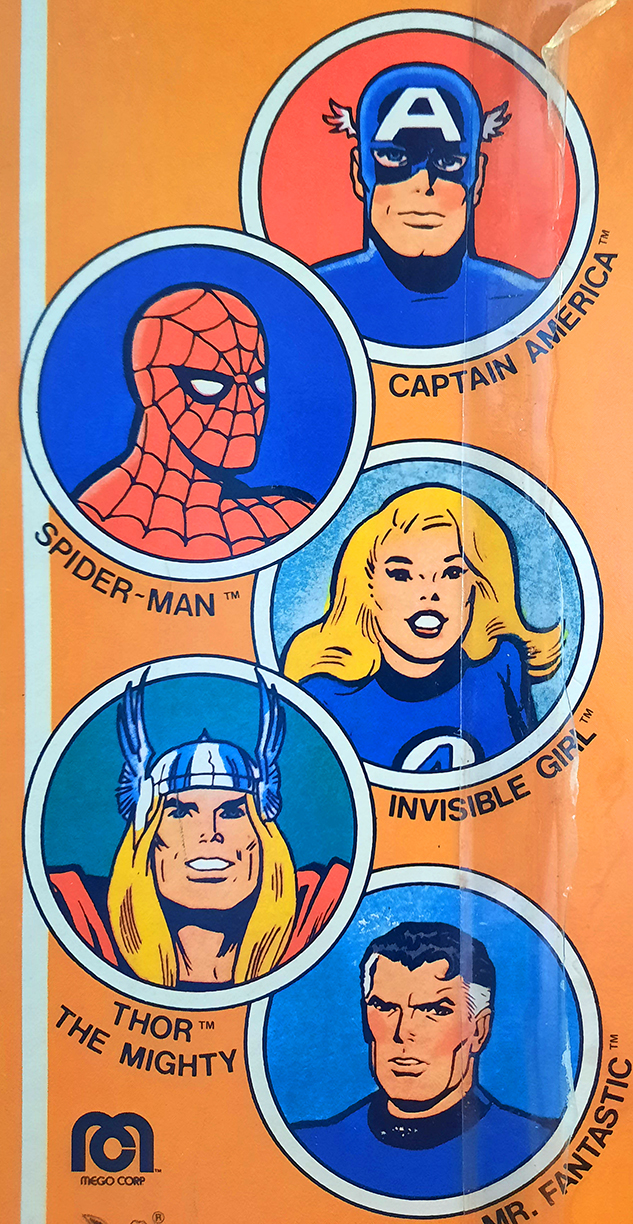
Mego package art courtesy of megomuseum.com
—
12. Marvel Public Appearance Posters. If you were lucky enough to ever visit a store when one of your favorite superheroes (or villains) made an appearance, consider yourself a True Believer! I got to see Spider-Man duke it out with the Green Goblin at a Hills Store in Lexington, Kentucky, in August 1980. It was life-changing, no joke! I’m fortunate that my mother kept the flyer, which Spider-Man and Green Goblin signed on the back.

And of course, most of the art (minus a very off-model ROM) was lifted from Romita’s work. Marvel would sometimes send out full-color posters to advertise the character appearances, and Romita’s art was tapped for a good chunk of them. Captain America’s running pose was lifted from the 1975 Marvel calendar, and Spidey crawling came from the Romita cover for Marvel Tales #100. Green Goblin was a line art version from the painted cover of the book Bring on the Bad Guys (more on that later).

Images courtesy of Brian Heiler at plaidstallions.com. For more on superhero store appearances, of if you have photos to share, check out Brian’s Toy-Ventures magazine, and his upcoming book, Mall of Justice!
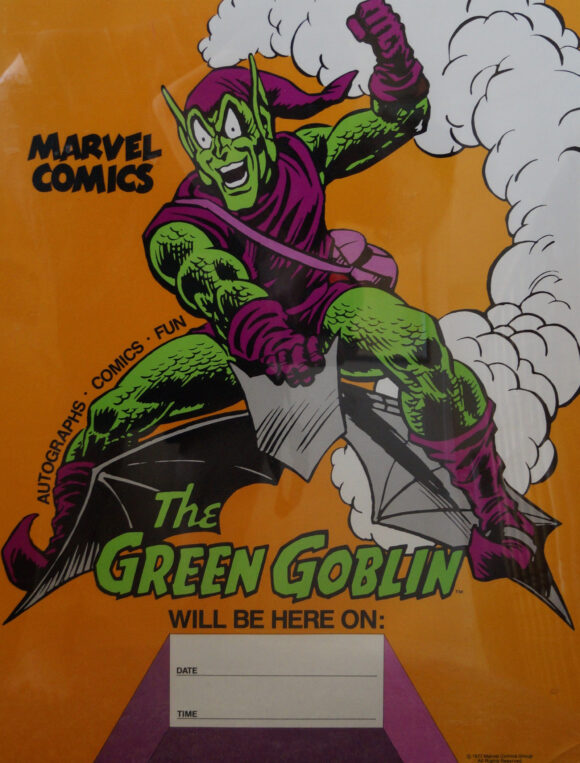
—
11. The Amazing Spider-Man Game With the Fantastic Four, by Milton Bradley. This is a personal favorite of mine, having had this game as a kid. The box art is pure Romita, with an image of a crawling Spidey used multiple times on countless pieces of merch, but I don’t think it looked any better than here. Flanking Spidey are Marvel’s first family, with the Storm siblings on one side of what appears to be the moon, and Reed and Ben on the other. Everyone looks so friendly!
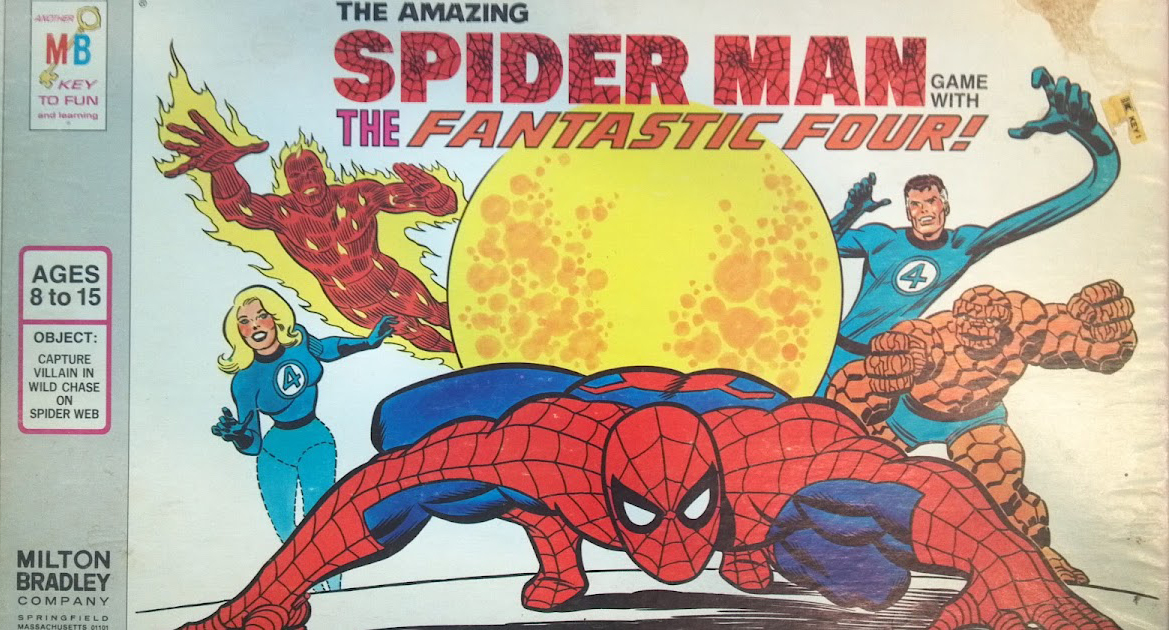
Image courtesy of aboardgameaday.blogspot.com
The game board itself is interesting, with a Romita Spider-Man bust in the center, but the rest of the FF art appears to be primarily by John Buscema and even Jack Kirby. Even more interesting are the Spider-Man action images on the side, lifted from classic Steve Ditko art of the ’60s. But it’s that Romita box art that grabbed you in the gaming aisle!
—
10. Spider-Man Hot Cycle, by Empire. Who wouldn’t want a sweet ride decked out from tire to tire (to tire) with Jazzy John’s artwork? The Hot Cycle, by Empire, is decorated with more classic Romita Spidey iconography than you can shoot a web at, and proves, if it wasn’t Romita’s Spidey on merch in the ’70s, it just wasn’t right.
Essentially a Big Wheel by another name, the Hot Cycle has stock shots of Spidey’s face all over the front wheel, a classic swinging pose on the fork, and the iconic crouching shot from Marvel Treasury Edition #1 on the seat back! Empire also issued a Little Hot Cycle version that featured most of the same graphics at a smaller size, minus the seat back. Empire also made several other Spidey ride-ons, and vehicles intended for figures made by Mego, including a Spider-Van and Spider-Copter (which I own), also covered in some of the same Romita imagery.
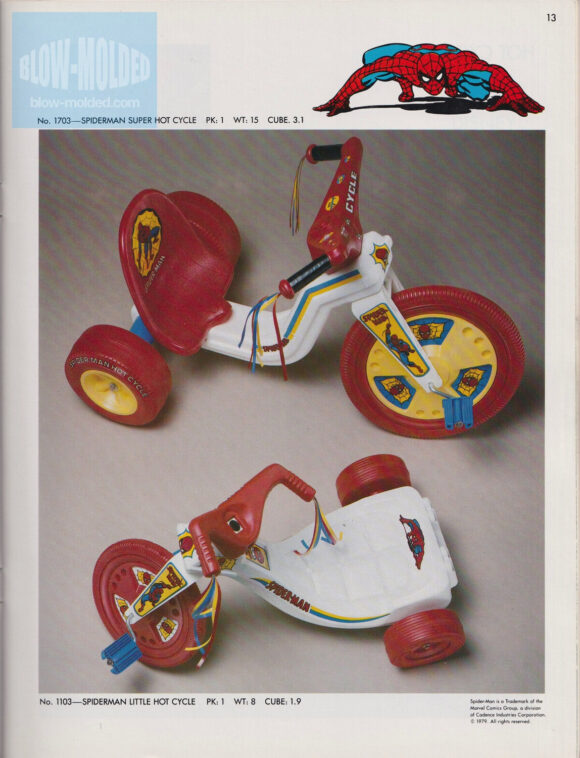
Image courtesy of blow-molded.com
—
9. Marvel Slurpee Cups. Another series of merchandise items often discussed here at 13th D are the various comic-related Slurpee cups from the ’70s. Most fans agree the artwork choices on the Marvel cups were far superior to their DC counterparts, and I can’t argue against that. Unfortunately, to this day, I’ve never set foot in a 7-11, because there’s just none around me (and never were)! But I can appreciate the iconic art emblazoned on each vessel destined for frozen goodness.

Previously commissioned Romita art covered many of these cups, most recognizably all three of the initial Spider-Man cups, Captain America (lifted from the 1975 Marvel calendar), Iron Man (from the cover of Iron Man #60) and Invisible Girl. Romita also contributed to the later, panoramic cups, which were also issued as glasses. Romita designed a promotional image for the campaign featuring Marvel’s “Big Four” of the late ’70s, and it’s pristinely iconic.
—
8. The Amazing Spider-Man Playset, by Ideal. Dan has covered this playset before, but the packaging art/front of the playset is so dynamic, we need to mention it here. I’m not sure if this is an original piece of art, or something lifted from another Spidey piece, but it’s certainly John Romita. The similar Superman and Batman sets have original art by Murphy Anderson, so I’m guessing Romita created this lovely iconic image for this toy, although it was used elsewhere.

Spidey is swinging and thwipping, and it doesn’t matter if he’s covering up his chest symbol, you know who it is. And with Romita at the helm, it looks right! Inside, the cardboard figurines of Spidey and his friends and foes aren’t by Romita, but they are certainly based on his interpretations of the characters. If they weren’t, well, what would have been the point in the first place?
—
7. The Amazing Spider-Man “Saving the World” Poster. This is another personal favorite, because I had this poster on my wall for years, basically from when it came out in 1990, until I moved out of my parents’ house. Even though it is an early ’90s poster, with then-new villains like Venom, Tombstone and Puma, the punchy tone feels very much like a fun ’60s/’70s throwback. The art proves Jazzy John still had it, giving us classic versions of Spidey and his foes, and fitting those new characters perfectly into the Romita-verse.
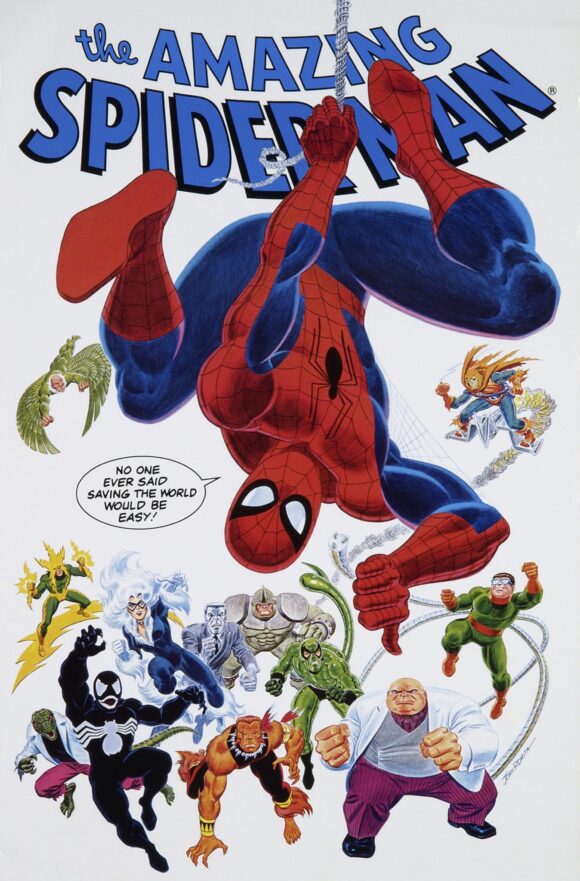
—
6. “Marvel Super-Heroes Are Here!” Black Light Poster, by Third Eye Inc. Another blast from the past Dan has raved about here at 13th Dimension are the trippy Marvel black-light posters produced by Third Eye Inc. in the early ’70s. Romita’s art is surprisingly absent from the posters Third Eye produced, except for the hard-to-find promotional poster announcing the arrival of the series.
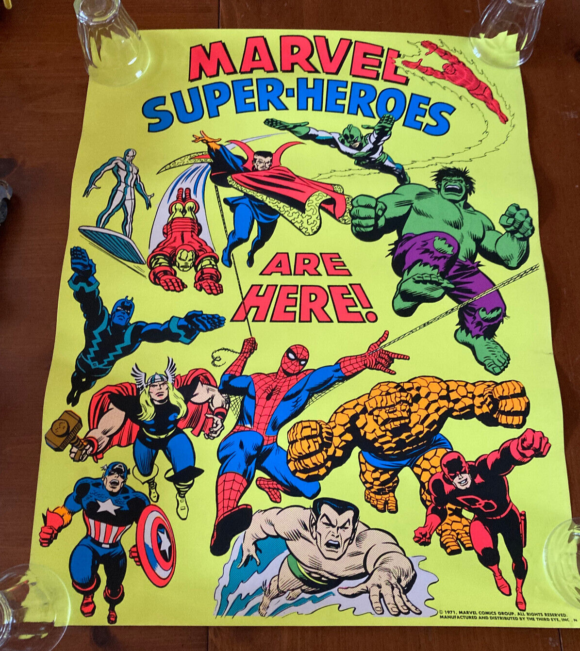
John drew all of Marvel’s then-headlining characters (including the Kree-uniformed Captain Marvel, Silver Surfer and Black Bolt of the Inhumans) coming at the viewer in a rather chaotic layout, but the energy crackles, even without the benefit of a black light. I’m particularly fond of the Hulk and his bad hair day! Hey, it was the ’70s, after all. If you can’t afford the original, the artwork is being repurposed for the cover of the black-light notecard set coming soon from Abrams!
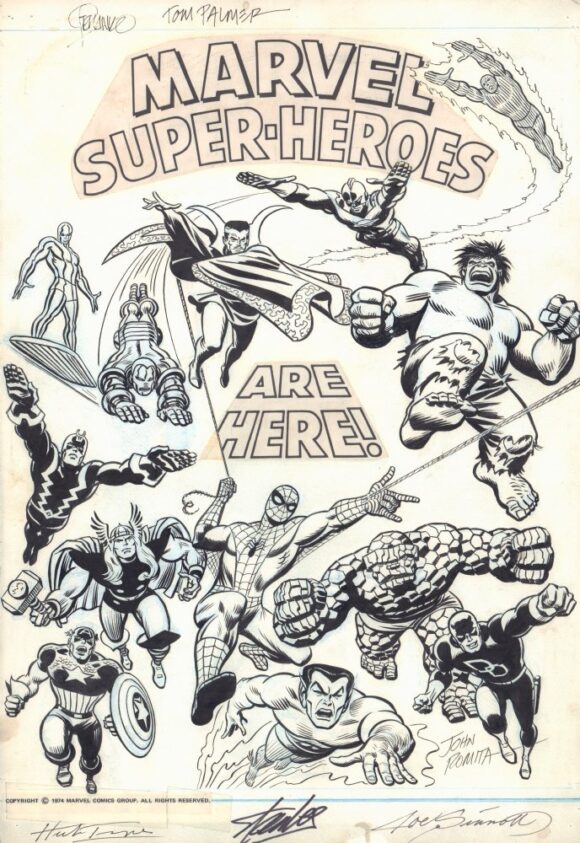
—
5. Spider-Man Video Game Ads and Blip Magazine Story. In 1982 Parker Brothers released the first Spider-Man video game to home consoles. The game itself was a lot of fun, and the graphics (believe it or not) were some of the best I myself experienced on the Atari 2600 system. (There’s a fun nod to the game in Spider-Man: Across the Spider-Verse!) But we’re here to talk about Romita, and Jazzy John worked on several projects to promote the game. First was a comic and magazine ad showing Spider-Man trying his hand at the game, while being taunted by the Green Goblin.
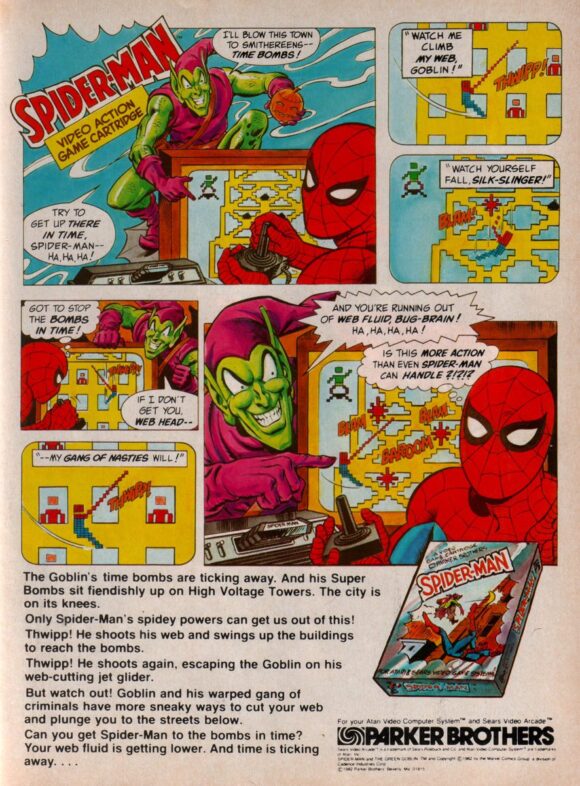
During the release of the game, Marvel launched a short-lived magazine focusing on video games called Blip. On the cover of Issue #2, an actor in a Spider-Man costume is seen playing the game. Inside, there is a 6-page store titled “End Game” (in a magazine called Blip! Who was the editor, Thanos?). The tale pits Spidey against the Goblin, and was written by David Anthony Kraft, and drawn by, you guessed it, John Ring-a-Ding Romita.
The story is a hoot, and very meta, with Gobby getting riled that kids are reliving his defeats at the hands of Spidey via the game. He terrorizes Parker(!) Brothers HQ, then shows up at a trade show where Spider-Man is promoting his own game. Romita’s art is slightly more simplified than his usually lush comic renderings, but he was aiming this at a younger, less-initiated audience. It’s still great to see a “hidden” Spidey story with him against his greatest foe, the first Spidey villain Romita ever got to draw, back in Amazing Spider-Man #39!
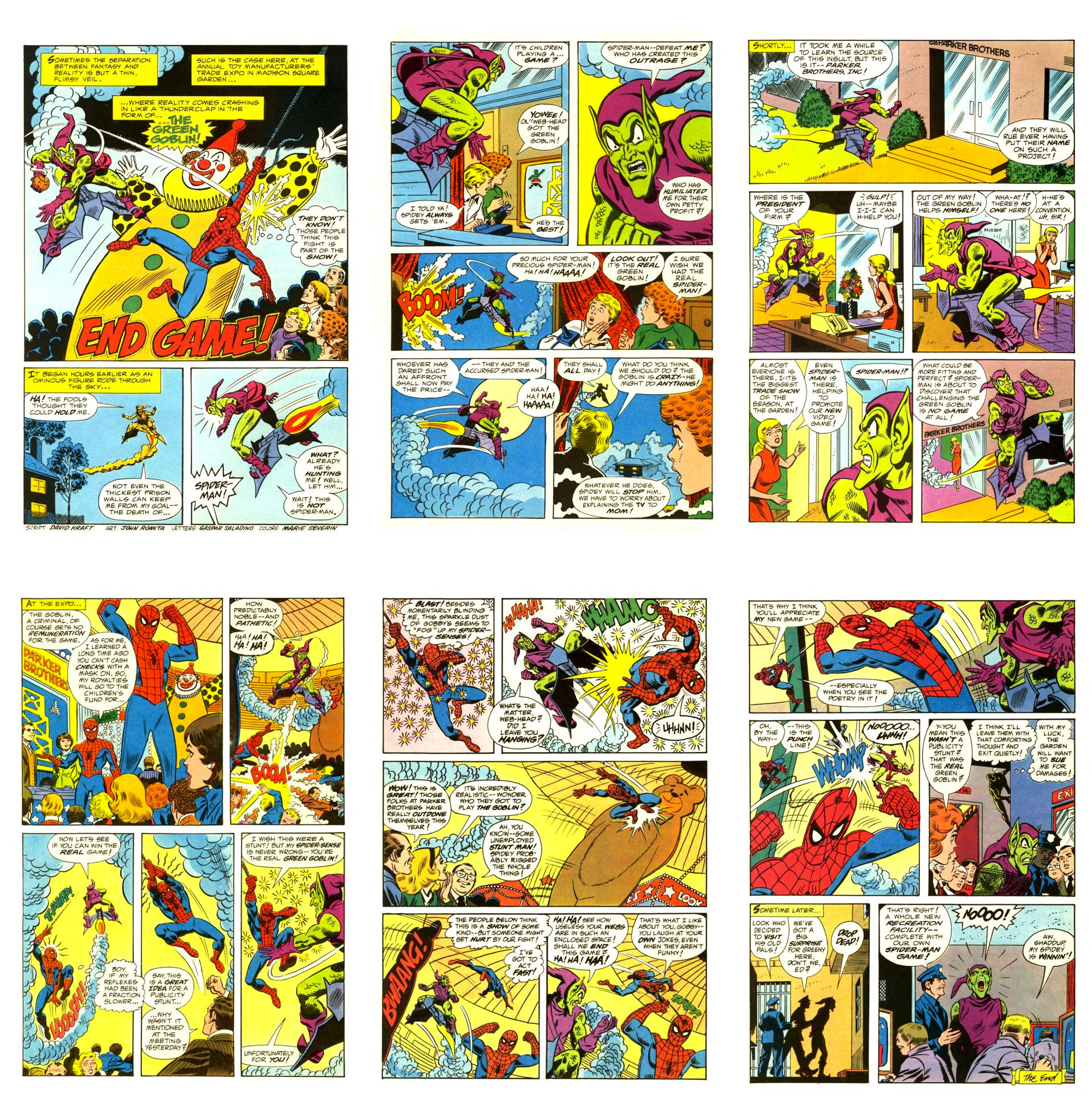
Courtesy of battlegrip.com
—
4. The Amazing Spider-Man: A Rockomic! Dan has featured this 1972 album on 13th D several times, but it definitely deserves to be on this list. Romita provided the front cover (which Mego then heavily reinterpreted for their initial Spider-Man packaging), the back cover and a series of comic strips tied to the album’s storyline.
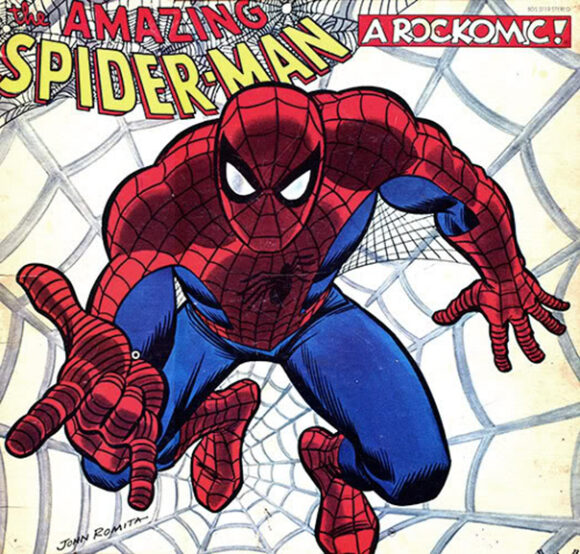
Not only did he get to illustrate Spidey’s origin, but a cadre of his biggest baddies (Green Goblin, Kingpin, Vulture and the Lizard), and also Marvel’s Sorcerer Supreme, Dr. Strange! Romita even provided the colors, which are equally phenomenal.
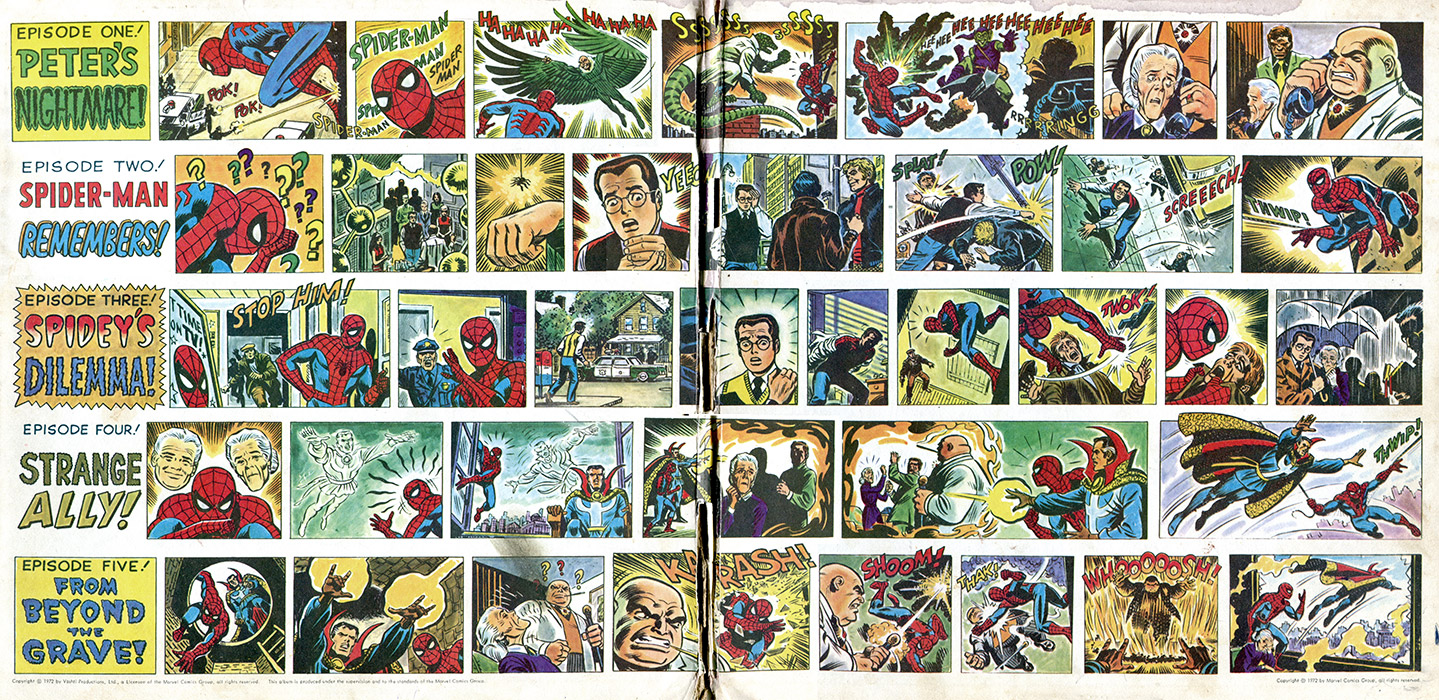
—
3. Spider-Man: Rock Reflections of a Superhero. A few years later in 1975, Spider-Man was on record shelves again (not counting all of those Power Records released around this time). Romita provided the essential artwork for the album cover — a downbeat but brightly colored Spider-Man surrounded by a beautiful sepia tableau painted by Nick Cardy.
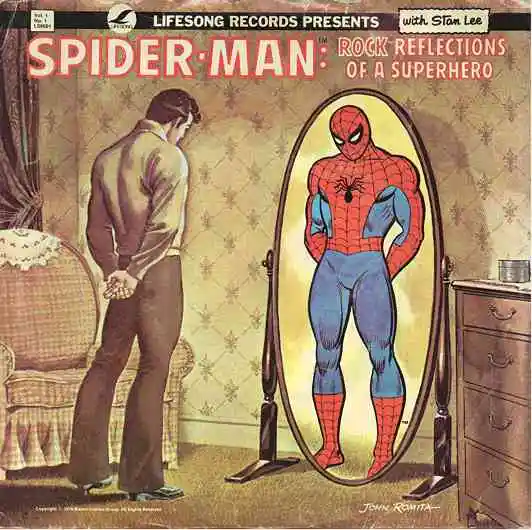
The back of the sleeve is even more fun, with Romita depicting various Marvel heroes (and then-licensed character, Conan) supposedly providing the music for the album! With the Fantastic Four on backing vocals, Black Panther on electric guitar and Hulk on the drums, how did this album not go triple platinum? It’s certainly no fault of the gorgeous artwork!
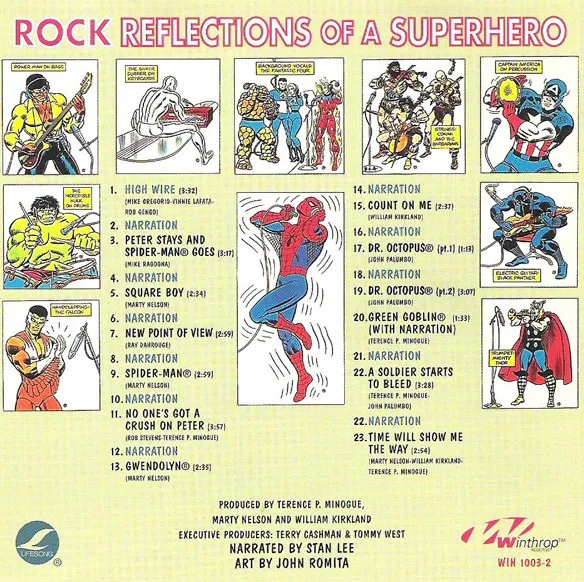
—
2. Marvel Fireside Books. In the late ’70s, Marvel inked a deal with Fireside Books to release a series of hardcover/softcover compilations of some of their greatest stories, credited solely on the covers to Stan Lee. This was essentially a forerunner to the lucrative trade paperback business that Marvel, DC and other publishers would slowly adopt in the 1980s. The first books, Origins of Marvel Comics shows a bevy of Marvel heroes leaping from the typewriter of Stan the Man. But of course, the painted art was by none other than Jazzy John.

Romita followed it up with an even greater cover for Sons of Origins, with Iron Man front and center, like it’s post-2008 or something. Perhaps his greatest contribution to the series was the iconic cover image of Bring on the Bad Guys, with the majestically malevolent Doctor Doom standing in the foreground, leading the charge of a group of Marvel’s most vile villains, including a Romita favorite, the Green Goblin, and also Red Skull, Loki and the hovering face of the demonic Mephisto. Of course, the cover for The Super Hero Women displays Romita’s unparalleled skills at drawing beautiful, strong ladies, honed from his years of drawing romance comics at DC. But Romita was no slouch at action, as the cover of Marvel’s Greatest Superhero Battles shows us, with the Hulk and the Thing ready to clobber the stuffing out of one another.
—
1. Marvel Calendars 1975-1979. Calendars were big in the ’70s! Both DC and Marvel jumped on the bandwagon, with DC relying heavily on Neal Adams to promote their heroes, and John Romita, of course, representing Marvel. The Jazzy One provided not only the cover art for the Mighty Marvel Calendar for 1975, (including Conan and Dracula!) but also several new interior pieces, such as Spider-Man’s cast kicking off the year in January. His piece for July featured the Falcon and one of the single most-iconic images of Captain America ever illustrated, which was then subsequently reused EVERYWHERE in the ’70s and ’80s (like Slurpee cups and store appearance posters)!

Speaking of Cap, he led Spidey and Hulk on a march of patriotic fervor on the cover of The Mighty Marvel Bicentennial Calendar in 1976. Romita continued the July tradition with Cap, this time having him stand before the Declaration of Independence, along with two colonial Minutemen. The following year, he inked over Jack Kirby’s pencils, with the heroes bursting from the cover of the Marvel Comics Memory Album Calendar 1977 (including Howard the Duck). He wrapped up the decade with a solo calendar cover for Spider-Man in ’78, and newly minted TV super-star the Incredible Hulk in 1979.
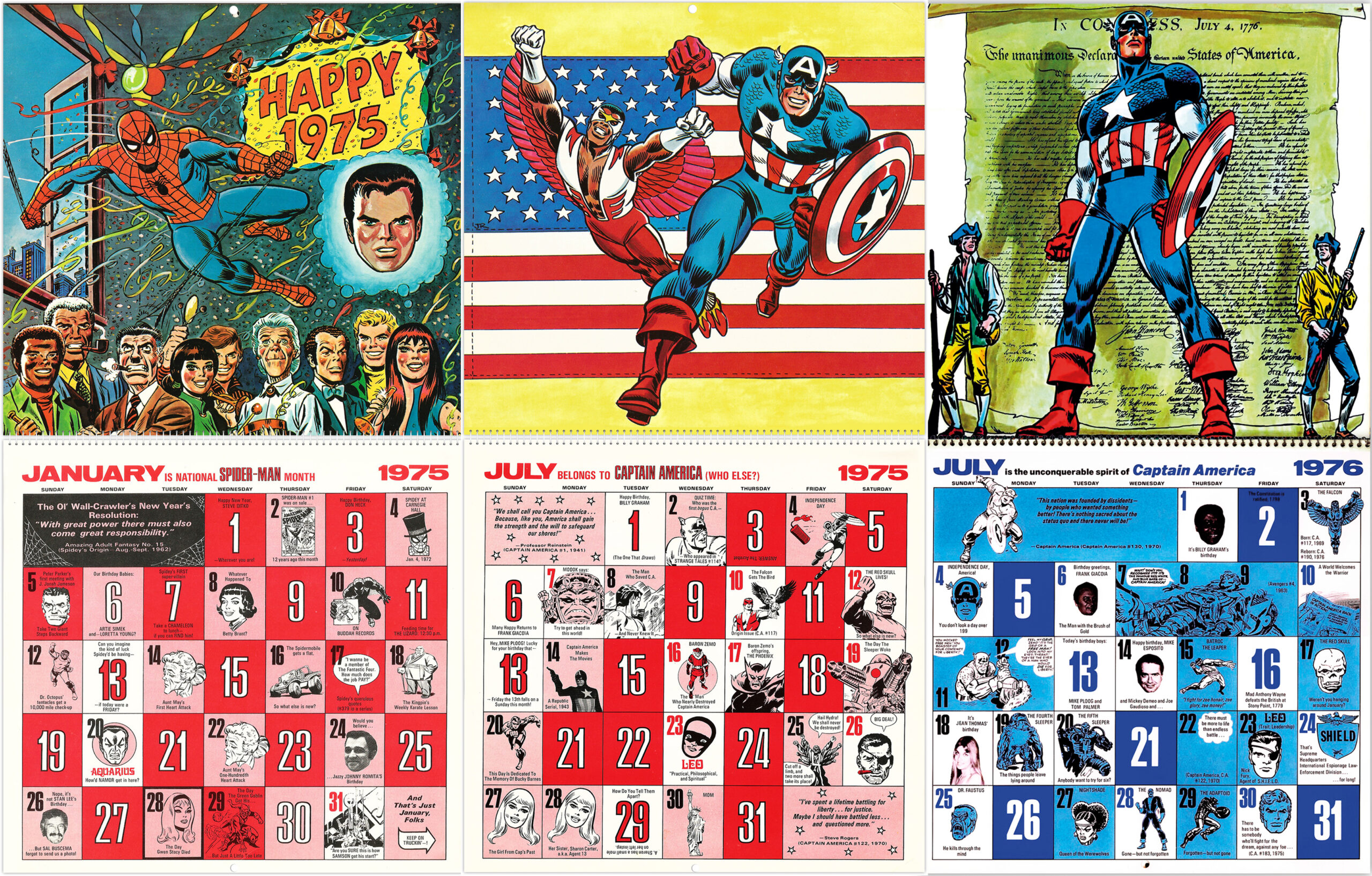
—
MORE
— The TOP 13 JOHN ROMITA SPIDER-MAN Covers — RANKED. Click here.
— JOHN ROMITA: What It Was Like Working on the Groovy SPIDER-MAN ROCKOMIC. Click here.
—
Chris Franklin is a graphic designer, illustrator, writer, and podcaster, who co-hosts several shows on the Fire and Water Podcast Network, including JLUCast, which he produces with his wife Cindy.

July 1, 2023
You forgot the cool Spider-Man running black light poster with black velvet-like texture.
July 2, 2023
Well, it’s just a sampling. I couldn’t include every piece of merchandise Romita contributed to, but it sounds really cool!
July 1, 2023
Very nice article! I did spot an error. The Rock Reflections record cover was not entirely done by John Romita. In fact, only the Spider-Man figure was done by Romita. The rest of the painted cover was done by Nick Cardy. Mr. Romita mentioned it in interviews and said that he always apologized to Nick Cardy, because Stan Lee made Romita sign his name at the bottom of the artwork!
July 2, 2023
Thanks for that information Bruce. I have never read that. And of course, I took the signature at face value, especially considering Romita obviously did painted work on his own. Now that I know, I can see Cardy in there. It’s similar to his movie posters of the time.
July 2, 2023
Fixed — and thank you Bruce!